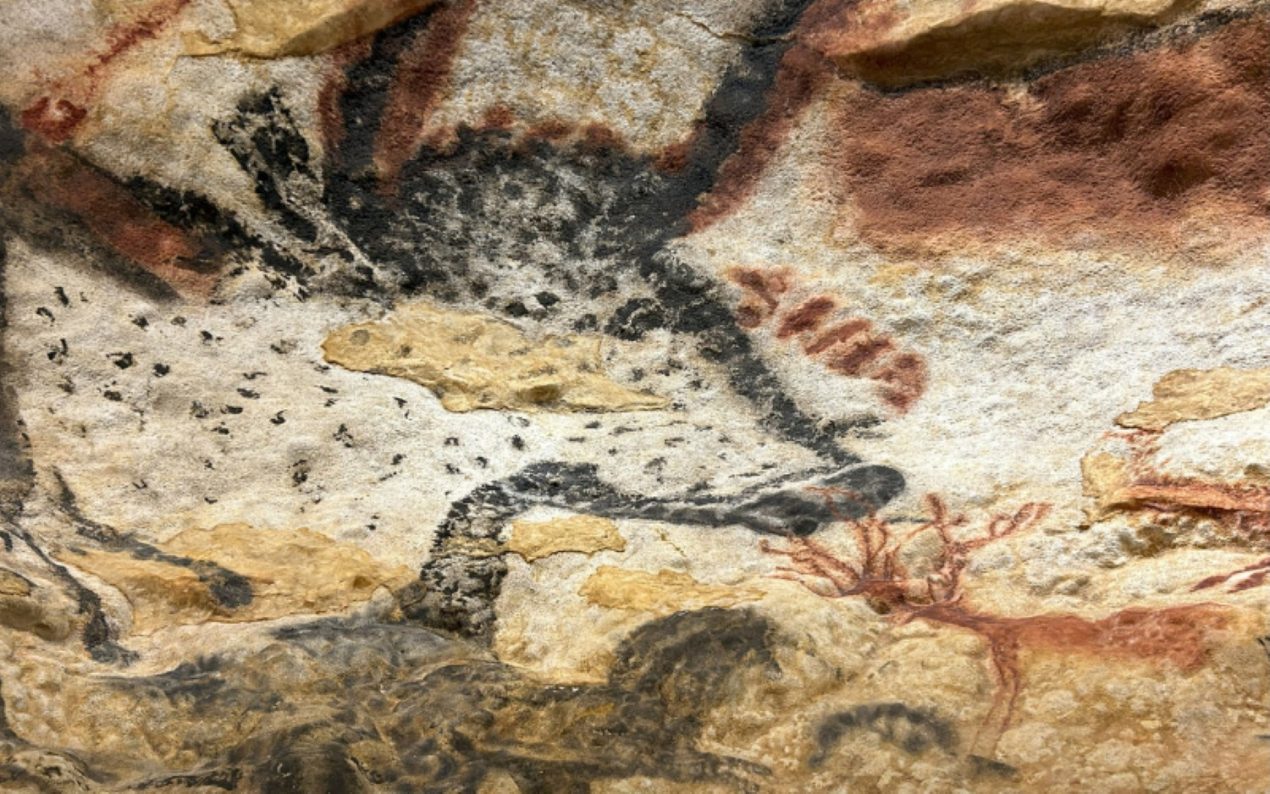Why Visit Lascaux IV in the Stunning Dordogne
Artsy Traveler contains affiliate links for products and services I personally use and can happily recommend. As an Amazon Associate, I earn from qualifying purchases. Please read the Disclosure for more information. If you make a purchase through these links, at no additional cost to you, Artsy Traveler earns a small commission. Thank you!
A visit to Lascaux IV in the Dordogne region of France is a must for the artsy traveler.
Here you will view the incredible prehistoric cave art created by our artistically-inclined ancestors over 30,000 years ago (give or take a few centuries).
The size, breadth, and sheer beauty of the paintings definitely will take your breath away.
In this post, I’m sharing my experience at Lascaux IV near the charming town of Montignac in the Dordogne region of France.

Location of Lascaux IV
The map below shows the location of Lascaux IV in the Dordogne region of France. It is close to the charming town of Montignac.
Some Background
The caves of Lascaux were discovered in 1940 by a group of young boys. For fifteen years, it was open to the public until finally being closed in 1963 after it was discovered that bacteria from visitors’ breath was eradicating the paintings at an alarming rate.
I first visited Lascaux II in 1995 almost reluctantly because I knew I wasn’t going to be able to see the “real thing”, so why bother?
Lascaux II
Lascaux II opened in 1984–an almost exact facsimile created to show tourists the paintings in the Great Hall of the Bulls and the Painted Gallery. Purist as I was back in those days, I didn’t think a facsimile could be as good as the real thing.
I was very wrong.
As a cave replica, Lascaux II was small, cramped, and fabulous. The magnificence of the prehistoric paintings blew us away, particularly inspiring Gregg (my husband & an artist–meet him on the About page) to create several paintings related to our visit.
I could hardly believe the paintings were in fact almost exact replicas of the real thing.
Lascaux III and IV
The Lascaux cave’s fame as the premier destination for prehistoric art lovers in France, or indeed all of Europe, continued to grow.
In 2012, reproductions of the paintings, called Lascaux III, were taken on the road.
Then, in 2016, the massive complex that now houses Lascaux IV and its accompanying museum opened to the public.
The Vézère valley as a whole contains 147 prehistoric sites dating from the Palaeolithic and 25 decorated caves, and has been designated a UNESCO World Heritage site.
Preparing to Visit Lascaux IV
Secure your reservations for the English tour weeks before you are planning to visit Lascaux.
There were only three English tours available daily during the three days I was staying in the Dordogne Valley. Even a month out, only a few spots remained in the time slot I wanted (11:10 am).
I snapped up the tickets, printed them off, and looked forward to the ultimate prehistoric treat.
I knew the paintings themselves would not have changed since I saw them in Lascaux II back in 1995, but I was interested to see how the Lascaux IV iteration had enhanced the experience.
Buy Tickets in Advance at https://www.lascaux.fr/en or combine with a tour that includes transport from Sarlat-la-Canéda.
Touring Lascaux IV
I arrive about twenty minutes before the designated time slot and park in the huge lot across from the long, low modern building housing Lascaux IV, built below the hill that houses the real Lascaux cave.
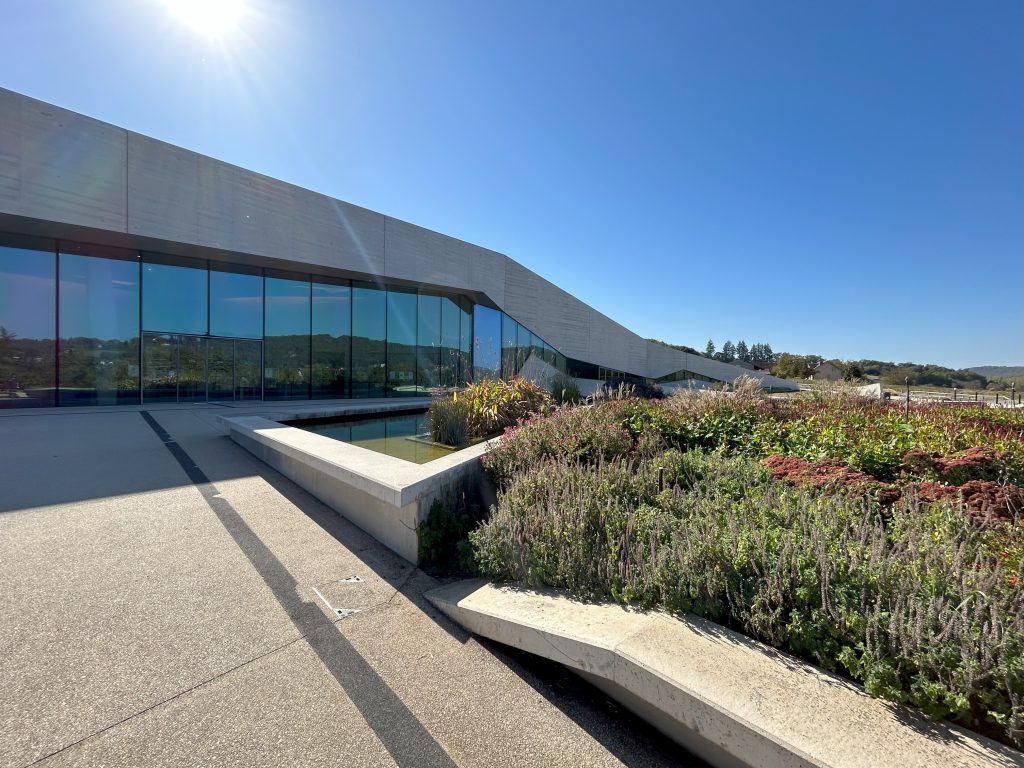
In the airy atrium, you can spend the time before your tour starts browsing the gift shop and discovering a whole new level of Lascaux-themed merch.
Before leaving the gift shop, I can’t resist snapping a pic of a whole wall of prehistoric animal stuffies. Is life truly worth living without a stuffed mammoth? I think not.
Enjoying this post? Subscribe to Artsy Traveler to Receive Valuable Travel Tips and Your FREE Guide: 25 Must-Do Artsy Traveler Experiences in Europe for 2025

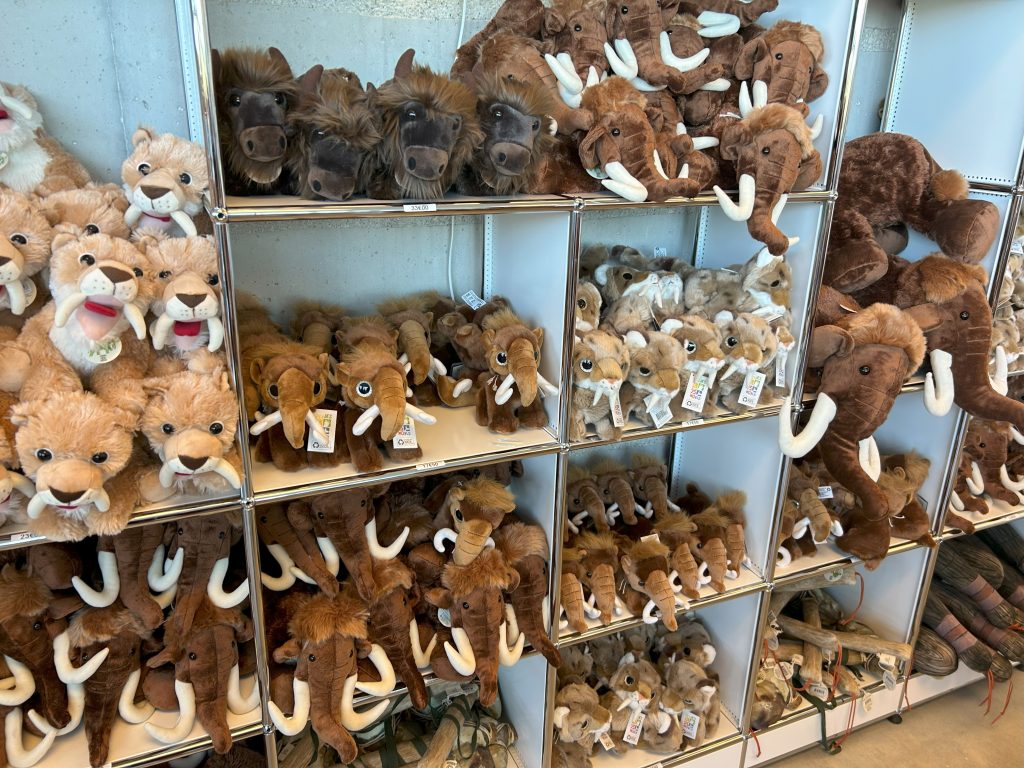
The tour begins with a flurry of English-speaking people affixing headsets and audio receivers as the cheerful guide asks if we are “hearing my voice in your head?”
After several minutes, all thirty or so of us are kitted out and the tour begins in an elevator.
Starting Outside Lascaux IV
We zip up to the roof of the low-slung building and learn about the discovery of the Lascaux cave in 1940. A man was out with his dog Robot (yep, that was the dog’s name) and discovered the narrow entrance to the cave at the top of the wooded hill behind the building. He returned the next day with three boys.
They entered the cave through a 15-metre-deep shaft and discovered cave walls covered with depictions of animals—aurochs, bison, deer, horses, and more.
Our guide plays up the drama of the discovery and then invites us to cast ourselves back 30,000 years to imagine leaving the fresh air to clamber into a dark cave.
He reminds us frequently that the humans who created the paintings in Lascaux are the same as us, biologically speaking. They were Cro-Magnon, relatively recent arrived in the area which had been inhabited for several hundreds of thousands of years by their Neanderthal cousins.
Entering Lascaux IV
With a flourish, the door slides open and we troop into the narrow cave. Our guide exhorts us to proceed in total silence and with reverence for what we are about to witness. He does a good job of setting the scene.
My art sensors are on high alert.
The door slides shut behind us and we are in the first room.
Arching high above us and on the walls either side are an awe-inspiring jumble of painted animals. Some overlap, and the prevailing impression is one of constant, joyous movement. Looking up in the eerie light cast by the guide’s flashlight, the animals sway and gallop across the uneven surfaces of the cave.
Each bump and swell of the simulated rock has been incorporated into the bodies of the animals in exact imitation of how the animals appear in the real cave.
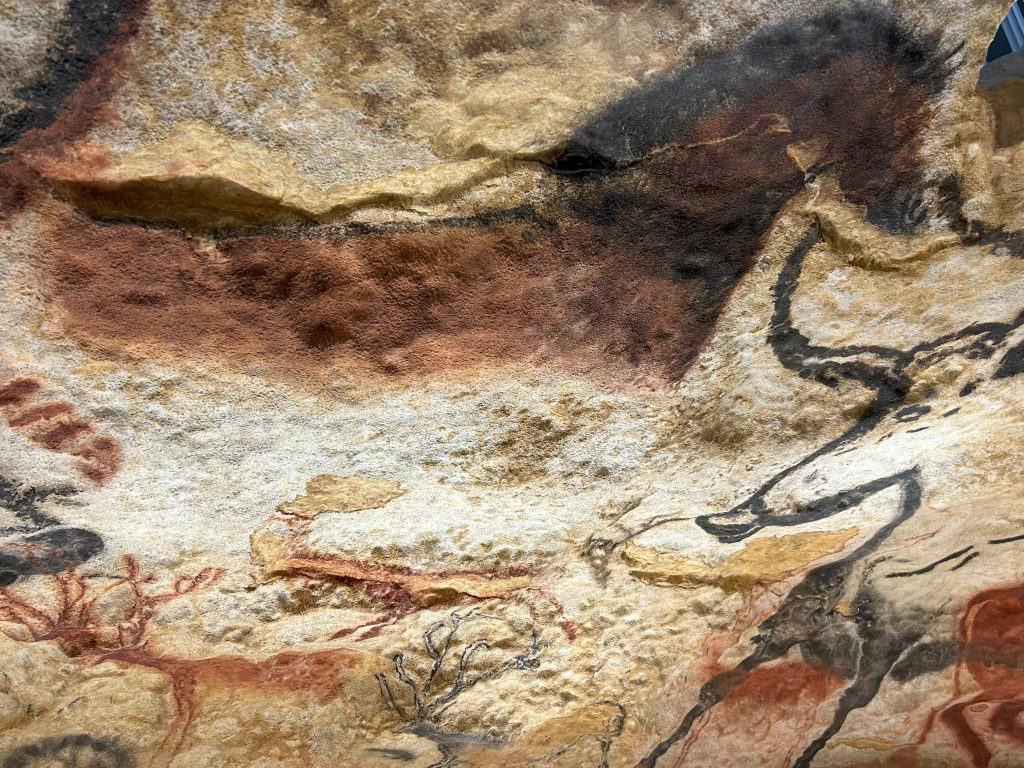
Description of Images
The images of animals cavorting above us are not primitive scratchings on a rock wall. This is the prehistoric Sistine Chapel. The beauty and freshness of the vividly colored animals explode in front of us. We gasp with wonder and respect. These early painters truly were artists.
Throughout the tour, the guide emphasizes that we have no idea why the long-ago artists made these paintings. The prevailing theory is that they were made because the artists wanted to make them.
In other words, these cave artists were not much different from an artist in any period. They created the animals they saw outside the cave in all their kinetic glory because, well, they just kinda felt like it. Perhaps they painted during the winter when game was scarce.
Being inside a relatively warm and cozy cave was better than being outside in the snow. Who knows!
Types of Images in Lascaux
The cave contains nearly 6,000 figures, the vast majority of which are animals. One bird-headed human figure appears in a shaft that they don’t include in Lascaux IV (but show in the museum).
The cave also includes various symbols whose meaning archeologists have yet to determine.
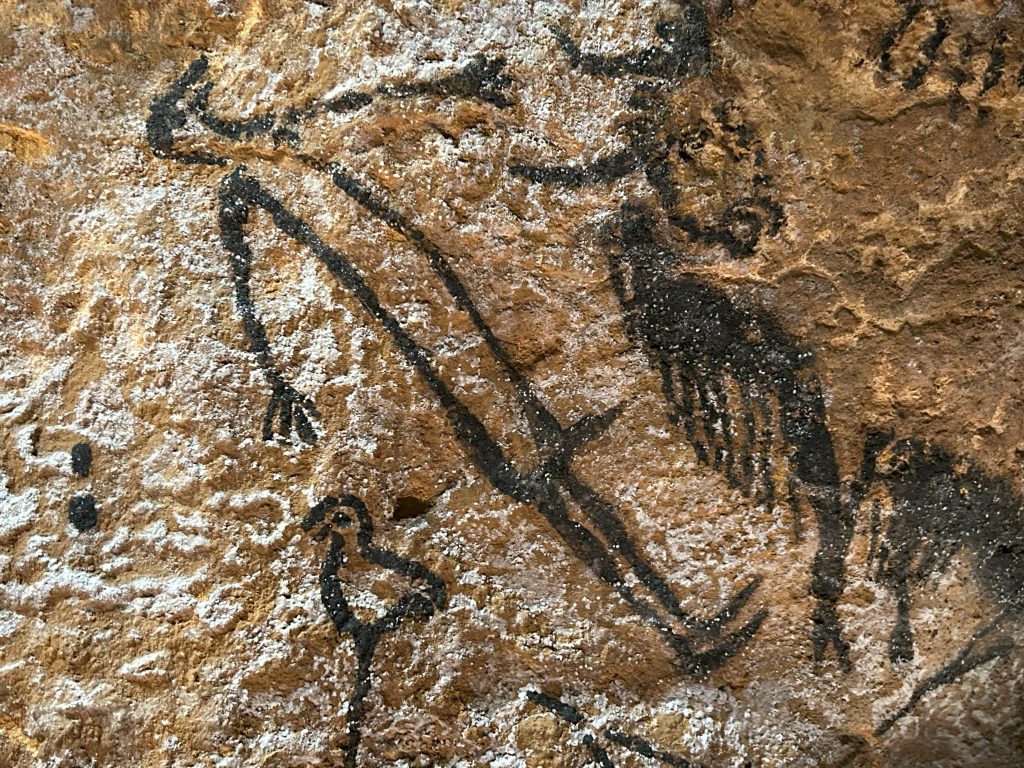
There are no images of the surrounding landscape or the local vegetation. The animals charge across the cave walls and ceiling unencumbered by gravity.
Creating the Images
The artists used three colors: red, yellow, and black made from minerals and sometimes mixed with grease. Tools used include early versions of brushes along with tubes for blowing the paint onto the rock.
The museum we enter after touring the replica cave provides many more details.
Hall of the Bulls
First up is the Hall of the Bulls. The clarity, brightness and size of the many images is spectacular. Each animal looks like it was painted yesterday, which is sort of true since it’s a replica, but it’s a replica of what the real caves look like.
The Hall of the Bulls contains 130 figures, including cows, horses, aurochs, and the only bear in the cave. One of the bulls is enormous. Spanning 5.5 meters, it’s the world’s largest known prehistoric representation of an animal.
Also in the hall is the first unicorn—a representation of an animal that never existed in nature.
What was the artist thinking? Why did he or she choose to paint it?
We’ll never know. The guide spends a lot of time focusing on the unicorn and speculating.
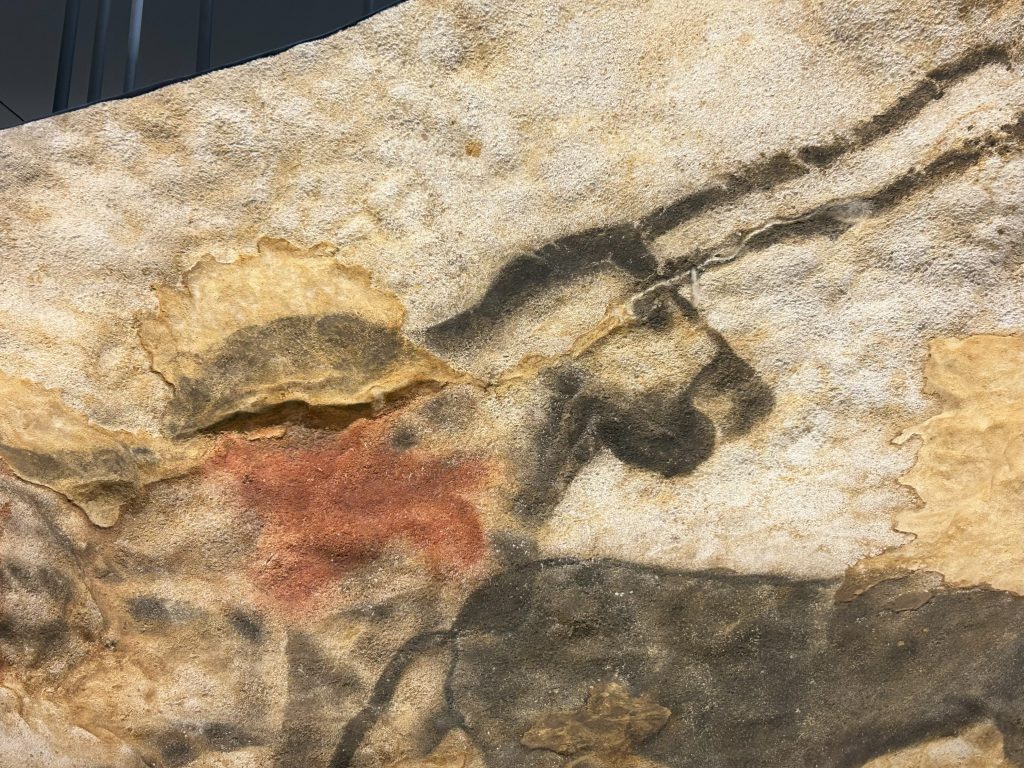
Axial Gallery
We keep going through the hall to the axial gallery, a 30-meter passage dubbed the Sistine Chapel of Prehistory.
My favorite is the line of small horses merrily cantering along one wall. Called the Frieze of the Small Horses, they face the direction of the entrance to the Axial gallery. Each one is different in color, size, and shape.
Overhead flow more horses and bulls and cows and aurochs and even two ibexes in a joyous celebration of movement and color.
Below is a stock photo of one of the ceilings. Photography inside the replica cave is forbidden so I wasn’t able to snap my own pics.
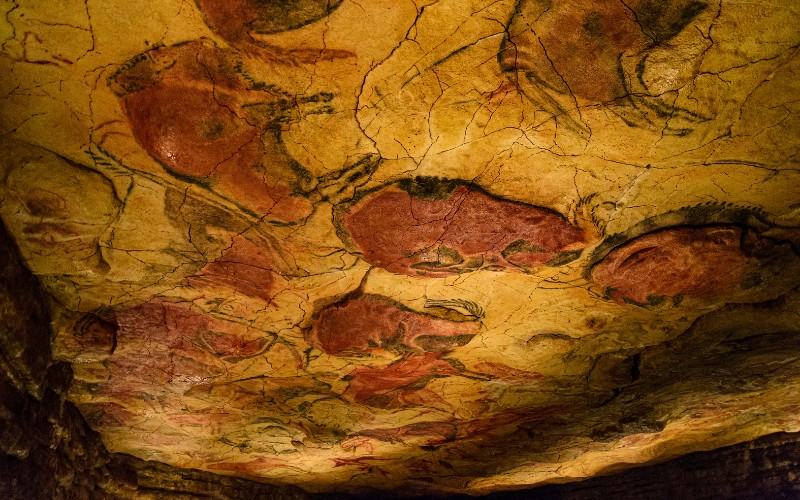
Five large stags follow in a row, only their heads and antlers visible as if they are swimming.
Also there are two black bison facing back to back with the rump of one placed just ahead of the other to give a 3D effect. They look like they are galloping off in opposite directions.
Where Are the Reindeers?
Being inside the replica cave is somewhat claustrophobic and yet wondrous at the same time. I try to imagine what compelled people just like me to lower themselves into a cave and use tools and pigments to cover walls with a riot of animals in motion.
And what’s even more astonishing is that not one of the animals depicted is a reindeer—the most plentiful animal roaming the landscape at the time.
Why did the artists only depict the less common animals instead of the one they depended on most for food? Again, no one knows.
The population of France during the time when the paintings were created was less than 50,000 people. And yet a fair number of them must have been artists, considering the large number of painted caves in the Dordogne area, elsewhere in France, and in northern Spain.
The guide tells us that all the painted caves in existence will never be discovered.
Ending the Tour
At the end of the tour, we emerge into the sunlight to the sound of running water. The guide asks us to consider the role water played in creating caves of hollowed-out rock beneath the earth.
After answering questions, the guide leads us into the museum. Here, each of the main panels in the caves is reproduced so we can study them more closely and also take pictures. As mentioned, photography is forbidden within the caves.
Exploring the Museum
The museum is very high-tech and stylish.
After snapping pictures of my favorite parts of the cave, I check out some of the interactive stations where people are invited to try “painting” on the screen using the colors and tools available to the cave artists. It’s all very cleverly done.
Once out, we make a quick pit stop at the gift shop and load up on Lascaux-themed merch.
I buy myself a Lascaux mouse pad, a fridge magnet to add to our growing collection, a stylized figurine of an auroch, and a book about Lascaux so we can read about what we’ve just seen.
Where to Stay in the Dordogne
You’ll find plenty of quaint and picturesque places to stay in the Dordogne region of France. Les Eyzies du Tabac, about a 20-minute drive from Montignac is a good choice.
I stayed in the Comtess de Dordogne. The property includes a chateaux, a pool, gorgeous grounds, and cosy one-bedroom cabins. The place is also a short walk into Les Eyzies du Tabac where you can tour the marvelous Prehistory Museum.
Also good is Domaine de Monrecour near Sarlat and Hotel Les Glycines near Montignac.
Tour Options for the Dordogne
Here are some more options for guided tours of the Dordogne area of France. Allocate at least a week for the area. I stayed for just three days on my most recent trip, and it was not long enough!
Conclusion
A visit to Lascaux IV is a must if you’re traveling in the Dordogne area. It’s located close to the charming village of Montignac. Have you visited? Share your impressions and your tips for other artsy travelers in the comments.
Here are some more posts about wonderful things to see and do while traveling in France:
